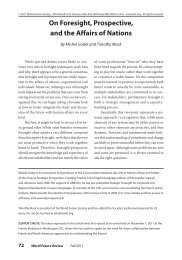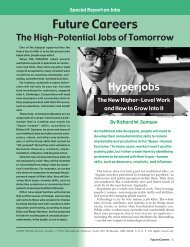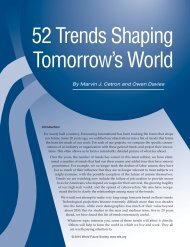Trends Shaping Tomorrow's - World Future Society
Trends Shaping Tomorrow's - World Future Society
Trends Shaping Tomorrow's - World Future Society
Create successful ePaper yourself
Turn your PDF publications into a flip-book with our unique Google optimized e-Paper software.
to replace the 8.4 million jobs lost to<br />
date in the post-2007 recession.<br />
• Of the workers who lost middleclass<br />
or better jobs during the 2001–<br />
2002 recession, an estimated twothirds<br />
were forced to accept positions<br />
that paid much less well and often<br />
required a radical loss of lifestyle.<br />
• In Europe, job losses are expected<br />
to top 20 million before the<br />
recession ends in 2010.<br />
• The economic turmoil of recent<br />
years is only partly responsible for<br />
this trend. It has accelerated the continuing<br />
replacement of human labor<br />
by computers and automation. In the<br />
United States, worker productivity<br />
rose by 6.9% (annualized) in the second<br />
quarter of 2009, 9.5% in the<br />
third, and 6.4% in the fourth. For<br />
more than a decade, most productivity<br />
gains have come in industries<br />
that have been reworking business<br />
processes to incorporate computers<br />
and automation.<br />
• In Europe, where companies<br />
have been slower to adopt computerized<br />
work methods, productivity<br />
gains have been just over half as<br />
quick as in the United States.<br />
• The other side of growing productivity<br />
is a declining need for human<br />
workers. If you raise productivity<br />
by 2.5%, you need 2.5% fewer<br />
workers to deliver the same amount<br />
of goods or services. Employment<br />
growth slows. And when productiv-<br />
ity grows faster than the market, employment<br />
declines.<br />
• As computers become more<br />
powerful, they can take over more<br />
jobs that now require human input.<br />
Within 10 years, they will be capable<br />
of carrying out almost any task that<br />
does not need actual human hands.<br />
Manufacturing already is all but lost<br />
to human labor. Service, management,<br />
and even many research jobs<br />
are next. Human workers will be employable<br />
only in jobs that cater to the<br />
wealthy, who enjoy the exclusivity of<br />
being waited on, and where they can<br />
get the job done even more cheaply<br />
than computers and automated machinery.<br />
Assessment and Implications:<br />
This trend is inevitable. The United<br />
States and other developed lands<br />
will become essentially jobless societies<br />
within the lifetimes of today’s<br />
younger adults. Other lands will follow<br />
as they become able to afford the<br />
necessary technology. The only questions<br />
left are of timing.<br />
One of the most important functions<br />
of a society is to distribute<br />
wealth so that the majority of people<br />
have at least the opportunity to provide<br />
a secure life for themselves and<br />
their families. The jobs-for-wages<br />
model adopted during the Industrial<br />
Revolution is losing the ability to fulfill<br />
this mission.<br />
Within 10 years, the United States<br />
will begin to follow Europe’s lead,<br />
reducing the workweek so that jobs<br />
and income can be divided among<br />
more people.<br />
The developed world faces a more<br />
severe decline in living standards<br />
than many people recognize. Eventually,<br />
it will be necessary to scrap<br />
the current system in favor of some<br />
other means of fairly distributing<br />
society’s wealth. Developing that<br />
system may be the most pressing unrecognized<br />
necessity now facing the<br />
United States and its peers.<br />
Population <strong>Trends</strong><br />
■<br />
The world’s population is<br />
growing rapidly, though not as<br />
fast as it once did.<br />
• Expect 9.2 billion people to feed<br />
by 2050.<br />
• Average annual growth worldwide<br />
peaked at 2.19% in 1963 and<br />
has fallen steadily since. The U.S.<br />
Census Bureau’s International Data<br />
Base projects that annual growth will<br />
fall below 1% in 2016 and below<br />
0.5% by 2047.<br />
• The greatest fertility is found in<br />
those countries least able to support<br />
their existing populations. Countries<br />
with the largest population increases<br />
between 2000 and 2050 include Palestinian<br />
Territory (217%), Niger<br />
STUDIO VISION / ISTOCKPHOTO<br />
THE FUTURIST May-June 2010 39
















